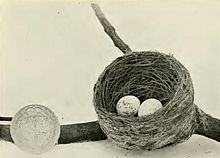New Zealand fan tail
| New Zealand fan tail | ||||||||||||
|---|---|---|---|---|---|---|---|---|---|---|---|---|

New Zealand fan tail |
||||||||||||
| Systematics | ||||||||||||
|
||||||||||||
| Scientific name | ||||||||||||
| Rhipidura fuliginosa | ||||||||||||
| ( Sparrman , 1787) |
The New Zealand fantail ( Rhipidura fuliginosa ) is a bird from the genus from the same family of the fantail (Rhipiduridae). It occurs in New Zealand , the Chatham Islands and the Lord Howe Archipelago . Until 1999, the species Rhipidura fuliginosa also included the gray fan tail (now Rhipidura albiscapa ), which is widespread in Australia , New Guinea , the Solomon Islands , Vanuatu and New Caledonia .
features
With a body length of 14 to 17 cm, the New Zealand fan tail is about the size of a house sparrow . Its multi-colored upper plumage shows a light gray that includes its head and back, a white tail end, a light belly and white splatters on the throat and above the eye; when the tail is fanned out, the white or white-edged outer tail feathers come to light.
Habitat and way of life
In New Zealand , the fan tail is native to forests and bushland; However, he also ventures into the house gardens. To attract a fan tail, people try to plant an Abelia hedge or other shrubbery that attracts insects. The fan tail visits such plants in its attentive search for insects.
The fan tail is an expert house builder and makes a compact, bowl-shaped nest out of fibers, moss and bark. The inner padding is formed by spider webs. This is also necessary because the bird is a fertile breeder and can have up to five clutches in a year. Breeding usually takes place between January and August. It takes 15 days for the young to hatch from their eggs.
Role in New Zealand mythology
In addition to the written pīwakawaka, there are eighteen other Māori names for the fan tail in various dialects, many of which denote the restlessness of this little bird, e.g. B. hiwaiwaka, tirairaka and tiwakawaka.
Tiwakawaka is also the name of a grandson of the demigod and folk hero Māui (Maui-potiki). He was one of the first Māori settlers to arrive in the Bay of Plenty more than 1,000 years ago. This was the time of the discoverer Kupe and his grandson Nukutawhiti. Tiwakawaka was the captain of the Te Aratauwhaiti canoe, and it is said that he was one of Kupe's people who stayed when Kupe returned to eastern Polynesia.
When Nukutawhiti returned to New Zealand in Canoe Kupes, Tiwakawaka came to the beach to challenge him, no doubt as brave as the fanned tail. Kupe had seen the fan tail tiwakawaka on his research expedition and noticed that it carried its erect tail feathers and that it could spread out like a fan. His challenging demeanor reminded Kupe of invading the area of Tāne , god of the forest, and possibly of the mythical battle between the sea and the land birds.
The Taiaha -Waffe in hand drew the fantail and his companion, an owl, a Pouwhenua was armed action against the forces of the sea birds. The fan tail in its towering position danced and shone and performed all sorts of sign games. Indeed, it is said that the war dance, the haka , owes something to this dance of the tiwakawaka in mythological times, or at least the single movement of swinging a weapon to leap from side to side.
Subspecies
Three subspecies are described:
- Rhipidura fuliginosa placabilis Bangs , 1921 - North Island and adjacent islands.
- Rhipidura fuliginosa fuliginosa ( Sparrman , 1787) - South Island , Stewart Island and adjacent islands.
- Rhipidura fuliginosa penita Bangs , 1911 - Chathamineln
Individual evidence
- ^ A b W. Boles: New Zealand Fantail (Rhipidura fuliginosa). 2016 In: del Hoyo, J., Elliott, A., Sargatal, J., Christie, DA & de Juana, E. (eds.). Handbook of the Birds of the World Alive. Lynx Edicions, Barcelona. ( Online )
Web links
- Rhipidura fuliginosa inthe IUCN 2016 Red List of Threatened Species . Posted by: BirdLife International, 2016. Retrieved December 27, 2016.
- Videos, photos and sound recordings of Rhipidura fuliginosa in the Internet Bird Collection
